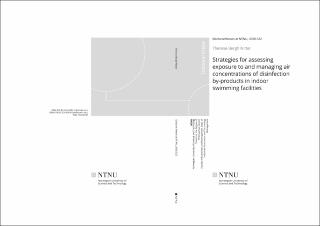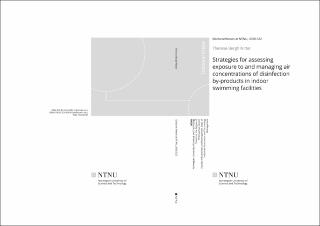| dc.contributor.advisor | Svendsen, Kristin von Hirsch | |
| dc.contributor.advisor | Jørgensen, Rikke Bramming | |
| dc.contributor.advisor | Carlucci, Salvatore | |
| dc.contributor.author | Nitter, Therese Bergh | |
| dc.date.accessioned | 2020-10-21T06:11:12Z | |
| dc.date.available | 2020-10-21T06:11:12Z | |
| dc.date.issued | 2020 | |
| dc.identifier.isbn | 978-82-326-4993-8 | |
| dc.identifier.issn | 1503-8181 | |
| dc.identifier.uri | https://hdl.handle.net/11250/2684003 | |
| dc.description.abstract | Norway has approximately 900 public, private, and leisure swimming facilities used for swimming education, recreation, and sports. Chlorine is the most common disinfectant used in swimming pool water to prevent the growth of microorganisms. However, while maintaining the chlorine concentration in a pool, continuous reactions between chlorine and organic and inorganic materials take place, which leads to the formation of inorganic chloramines and other disinfection by-products (DBPs) such as trihalomethanes (THM). The only group of DBPs which is controlled in Norwegian swimming pool waters is inorganic chloramines, often referred to as combined chlorine. To mitigate the water concentration of combined chlorine, UV treatment is often used as a secondary disinfectant in addition to chlorine. However, the results of some studies suggest that UV treatment increases chlorine reactivity and the formation of chlorinated DBPs in pool water.
An increased prevalence of asthma and other respiratory irritations has been found among users who visit swimming pools on a regular basis. These health effects are most often linked to long-term exposure to a volatile inorganic chloramine, trichloramine (NCl3). In 2019, the Nordic Expert Group proposed an occupational health-based limit value for air exposure to NCl3 of 0.2 mg/m3 (stationary air samples). Another important group of DBPs is the trihalomethanes (THM), as represented by the four components chloroform (CHCl3), bromoform (CHBr3), bromodichloromethane (CHBrCl2), and dibromochloromethane (CHBr2Cl). The four components are referred to together as total THM (tTHM), and all are formed in the pool water when chlorine reacts with natural organic matter. The tTHM are volatile and can penetrate the skin easily, making both inhalation and dermal absorption important pathways of exposure. Long-term health effects, such as adverse reproductive outcomes, cancer, and stillbirth, have been associated with exposure to tTHM. As of today, no limit value for exposure to these compounds exists in Norway, and the determinants causing the exposure concentrations to vary over time have not received much attention. The main purpose of this Ph.D. thesis is to identify strategies to assess and manage air exposure in indoor swimming pool facilities and to estimate the prevalence of health effects amongst the most exposed swimmers in Norway.
The method of repeated measures was used to quantify the within and between variability of different predictor variables on air concentrations of tTHM and identify the most important determinants for exposure assessment. The method of repeated measures was also used to assess how strategies for air and water quality determine the variability observed in the air concentration of CHCl3. An exploratory study was conducted to study how the use of UV treatment in pool water affects the overall air concentrations of tTHM and NCl3 and the covariation between these two exposure variables.
Monitoring components in the air, such as tTHM and NCl3 is time-consuming, expensive, and requires skilled personnel. While carbon dioxide (CO2) sensors are used for controlling air quality in different buildings and can be installed in ventilation systems for continuous monitoring purposes, such sensors are not used in indoor swimming facilities. Also, the strategies for air and water treatment are more or less static and do not correspond to the dynamic bather load observed in swimming pools. The concentration of CO2 was measured to evaluate whether this component could be used to predict the number of occupants as well as the concentrations of tTHM and NCl3 in the air. In addition, the prevalence of health effects was studied amongst the most exposed swimmers in Norway.
For normally distributed data for which information was collected repeatedly over time, a mixed effect model was applied to analyse the results. This tool enables the within and between variance components in air concentrations to be estimated while adjusting for fixed and random effects. As a result, we can identify which determinants are affecting the variance components. Multiple logistic regression was used to estimate the odds ratio (OR) for health effects. The statistical analyses were performed using the Statistical Package for the Social Sciences (SPSS) 25 and Statistics and Data (STATA) MP 15.
One main conclusion of this thesis is that the air concentrations vary extensively, both in terms of different times of the day and days of the week. To collect representative samples, it was necessary to monitor concentrations during different exposure scenarios; otherwise, our exposure estimates could have been no more valid than random guesses. In cases where repeated samples were collected, methods accounting for the dependency between the repeated observations were used, as a correlation between the repeated samples collected of tTHM and NCl3 was found. Even when the water quality is within the required limit values, the air concentration of NCl3 and tTHM may vary extensively, with the concentration of NCl3 possibly exceeding the concentrations proposed by the Nordic Expert Group (0.2 mg/m3).
The results also showed that when the water concentration of combined chlorine increases, the air concentration of tTHM also increases. Furthermore, when the concentration of free chlorine decreases, the air concentration of NCl3 decreases. Therefore, a recommendation is that the concentrations of free and combined chlorine should be kept well below their upper acceptable limit values. The results suggest that the use of any UV treatment should be carefully evaluated, as using such a treatment may increase the overall air exposure to tTHM.
Rather, other methods for reducing the concentration of combined chlorine in the water should be implemented. As the air quality is highly dependent on the water quality, air and water quality should be treated as one system in which the air supply is controlled based on bather load and water concentrations of combined chlorine. Both tTHM and NCl3 should be monitored regularly in the air, and limit values for these components should be implemented.
Considering that the concentration of CO2 significantly correlates with occupancy and NCl3, CO2 sensors can be used to create a more dynamic air supply, on that corresponds to the need of the users in the poolroom and, at the same time, reduces the variability observed in the air concentrations of NCl3 and tTHM. The prevalence of health problems is greatest amongst the most exposed swimmers in poolrooms. Facilities hosting swimmers spending more than 16 hours in the water every week should have stricter requirements for pool water management and air quality than other facilities.
Through this thesis work, six research questions have been answered and new knowledge was created. | en_US |
| dc.language.iso | eng | en_US |
| dc.publisher | NTNU | en_US |
| dc.relation.ispartofseries | Doctoral theses at NTNU;2020:322 | |
| dc.relation.haspart | Paper 1: Nitter, Therese Bergh; Svendsen, Kristin V Hirsch. Determinants of Exposure and Variability of Trihalomethanes in the Air of Three Indoor Swimming Pools. Annals of Work Exposures and Health 2019 ;Volum 63.(5) s. 560-567
https://doi.org/10.1093/annweh/wxz024 | en_US |
| dc.relation.haspart | Paper 2: Nitter, Therese Bergh; Svendsen, Kristin V Hirsch. Modelling the concentration of chloroform in the air of a Norwegian swimming pool facility-A repeated measures study. Science of the Total Environment 2019 ;Volum 664. s. 1039-1044
https://doi.org/10.1016/j.scitotenv.2019.02.113
This is an open access article under the CC BY license (http://
creativecommons.org/licenses/by/4.0/). | en_US |
| dc.relation.haspart | Paper 3: Nitter, Therese Bergh; Svendsen, Kristin V Hirsch. UV treatment and air quality in a pool facility. Water Science and Technology 2019 ;Volum 80.(3) s. 499-506
https://doi.org/10.2166/wst.2019.291 | en_US |
| dc.relation.haspart | Paper 4: Nitter, Therese Bergh; Grande, Morten S.; Svendsen, Kristin V Hirsch; Jørgensen, Rikke Bramming; Carlucci, Salvatore; Cao, Guangyu. Can CO2 sensors in the ventilation system of a pool facility help reduce the variability in the trihalomethane concentration observed in indoor air?. Environment International 2020 ;Volum 138.(105665)
https://doi.org/10.1016/j.envint.2020.105665
This is an open access article under the CC BY license (http://
creativecommons.org/licenses/by/4.0/). | en_US |
| dc.relation.haspart | Paper 5: Nitter, Therese Bergh; Svendsen, Kristin V Hirsch. Covariation amongst pool management, trichloramine exposure and asthma for swimmers in Norway. Science of the Total Environment 2020 ;Volum 723
https://doi.org/10.1016/j.scitotenv.2020.138070
This is an open access article under the CC BY license (http://creativecommons.org/licenses/by/4.0/). | en_US |
| dc.title | Strategies for assessing exposure to managing air concentrations of disinfection by-products in indoor swimming facilities | en_US |
| dc.type | Doctoral thesis | en_US |
| dc.subject.nsi | VDP::Social science: 200::Economics: 210 | en_US |

